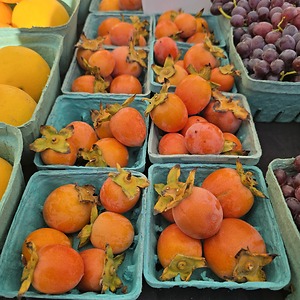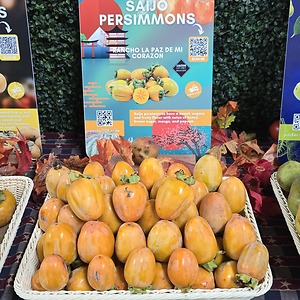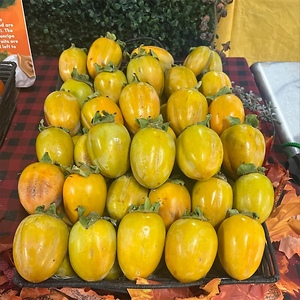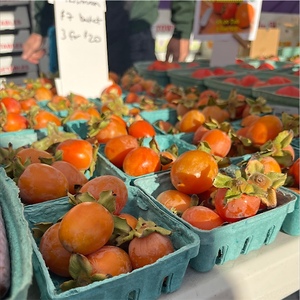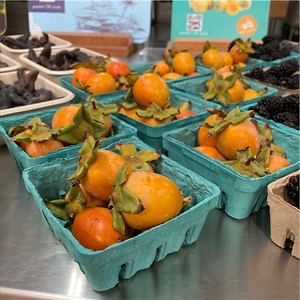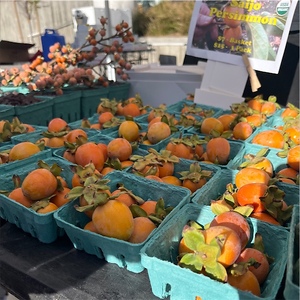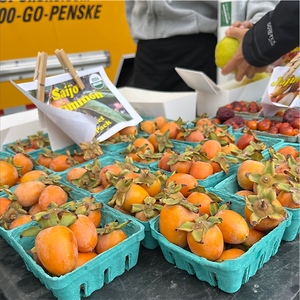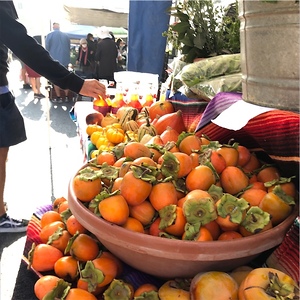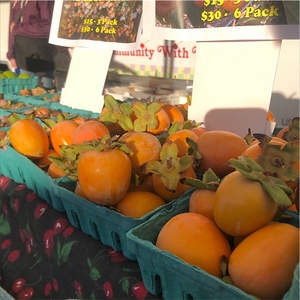

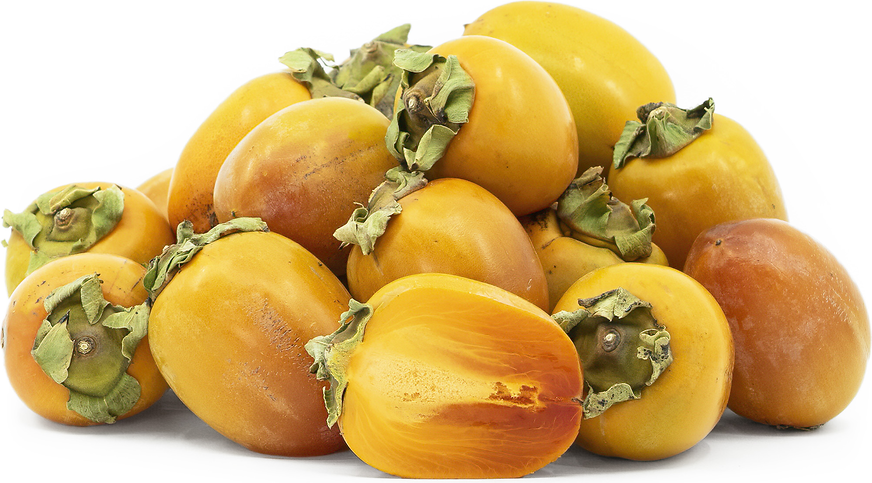
Saijo Persimmons
Estimated Inventory, bskt : 0
Description/Taste
Saijo persimmons are a small variety, averaging 5 to 7 centimeters in length, and have an oblong to elongated egg shape. The skin is smooth, taut, and pale yellow-orange when young, softening, slightly wrinkling, and developing darker orange hues with maturity. Underneath the surface, the flesh is firm, astringent, and unpalatable when unripe, producing an unpleasant tannic mouthfeel and insipid flavor if consumed. The fruits must be allowed to ripen fully, and during this process, the tannins in the flesh break down while the sugars increase, giving the flesh a soft, aqueous, custard-like consistency. The flesh is also a translucent, orange to yellow hue, and contains little to no seeds. Saijo persimmons have a sweet, sugary, and fruity flavor with notes of honey, brown sugar, mango, and papaya. To determine ripeness, select fruits that are soft to the touch with a heavy, almost squishy feel, similar to the consistency of a water balloon.
Seasons/Availability
Saijo persimmons are available in the fall through winter.
Current Facts
Saijo persimmons, botanically classified as Diospyros kaki, are small fruits that grow on a compact, deciduous tree reaching up to 7 meters in height, belonging to the Ebenaceae family. The oblong fruits grow in clusters and are highly valued for their unusual shape, small size, and sweet, seedless flesh. Saijo persimmons are an astringent variety, meaning they must be fully ripened before they can be consumed. The name Saijo roughly translates to mean “the very best one,” and was given to the variety for its flavor, appearance, and ornamental nature. Throughout Japan, Saijo persimmons are grown as a decorative landscape tree as the variety forms fragrant flowers in the spring and produces bright orange-red fruits and multi-colored foliage in the fall. Outside of Japan, Saijo persimmon trees are a novel variety grown in the United States and are considered one of the most cold-tolerant varieties for home garden cultivation. The variety is also favored for its high fruit yields and self-pollinating nature.
Nutritional Value
Saijo persimmons are an excellent source of fiber to regulate the digestive tract and vitamins A and C, antioxidants that strengthen the immune system while reducing inflammation. The fruits are also a good source of manganese to assist with protein digestion, potassium to balance fluid levels within the body and contain some calcium, magnesium, and phosphorus.
Applications
Saijo persimmons are an astringent cultivar that must be fully ripened before it can be consumed. When ripe, the tannins in the skin will break down, releasing sugar into the flesh and developing a soft, squishy consistency. The small fruits can be eaten fresh as a snack, removing the stem cap and scooping the flesh out with a spoon, or it can be used as a fresh topping over oatmeal, ice cream, and yogurt. Saijo persimmons can also be placed whole on cheese and fruit platters to showcase their unique size, or the flesh can be blended into smoothies, sauces, or served as a sweet accent in main dishes. In addition to savory applications, Saijo persimmons can be combined with sugar and used as a filling for baked goods, or they can be cooked into jellies, jams, and preserves. The fruits are also famously dried and consumed as a chewy, date-like snack. Saijo persimmons pair well with fruits such as pomegranates, plums, peaches, apples, and grapes, nuts such as hazelnuts, almonds, and walnuts, raisins, spices such as clove, anise, nutmeg, ginger, and cinnamon, vanilla, bourbon, honey, and brown sugar. Whole Saijo persimmons should be ripened at room temperature and may take a couple of days to a couple of weeks to fully mature, depending on how early the fruits were picked. Once ripe, the fruits should be immediately consumed as the quality and flavor will quickly deteriorate.
Ethnic/Cultural Info
In the region of Hata within the Shimane Prefecture of Japan, Saijo persimmons are the primary persimmon variety cultivated for drying and have been deeply intertwined with the region’s history. Hata is known for its mountainous landscape with dry winds, and along the mountainsides stand ancient persimmon huts, which are large, multi-floor buildings with removable walls. Each persimmon orchard in the region has its own persimmon hut for drying, and Saijo persimmons are harvested, strung on long, vertical strands, and hung in the air to form walls of bright orange-red fruits. Drying persimmons typically occurs on the second and third floors of the persimmon huts, and the first floor is reserved as a workspace to peel and string the fruits. Saijo persimmons have been grown in Hata for over 200 years, and approximately 20,000 to 30,000 fruits are dried in one persimmon hut. During the drying process, growers monitor the temperature, humidity, and airflow within the huts 24 hours a day to ensure the fruits dry into a sticky, soft, and chewy consistency. Dried Saijo persimmons are honored as a traditional food of the Hata region, developed from patience, effort, and experience, and the dried persimmons are sold under the name hoshigaki in specialty markets throughout Japan.
Geography/History
Persimmons are native to China and were cultivated for centuries before spreading to Korea and Japan in the early ages. Many different varieties of persimmons were developed over time through increased cultivation, including Saijo persimmons, and in the mid-19th century, the fruits were introduced to the United States through plantings in Florida and California. Today Saijo persimmons are commercially cultivated throughout Japan, China, and Korea and are found through fresh markets, supermarkets, and online stores in fresh and dried form. The astringent variety is also grown on a much smaller scale through select farms and in home gardens in the United States and are primarily found at farmer’s markets, specialty stores, and Asian grocers.
Recipe Ideas
Recipes that include Saijo Persimmons. One
| Joy of Kosher |
|
Persimmon Salsa |
| Perpetually Chic |
|
Roasted Persimmon & Coconut Quinoa Porridge |



